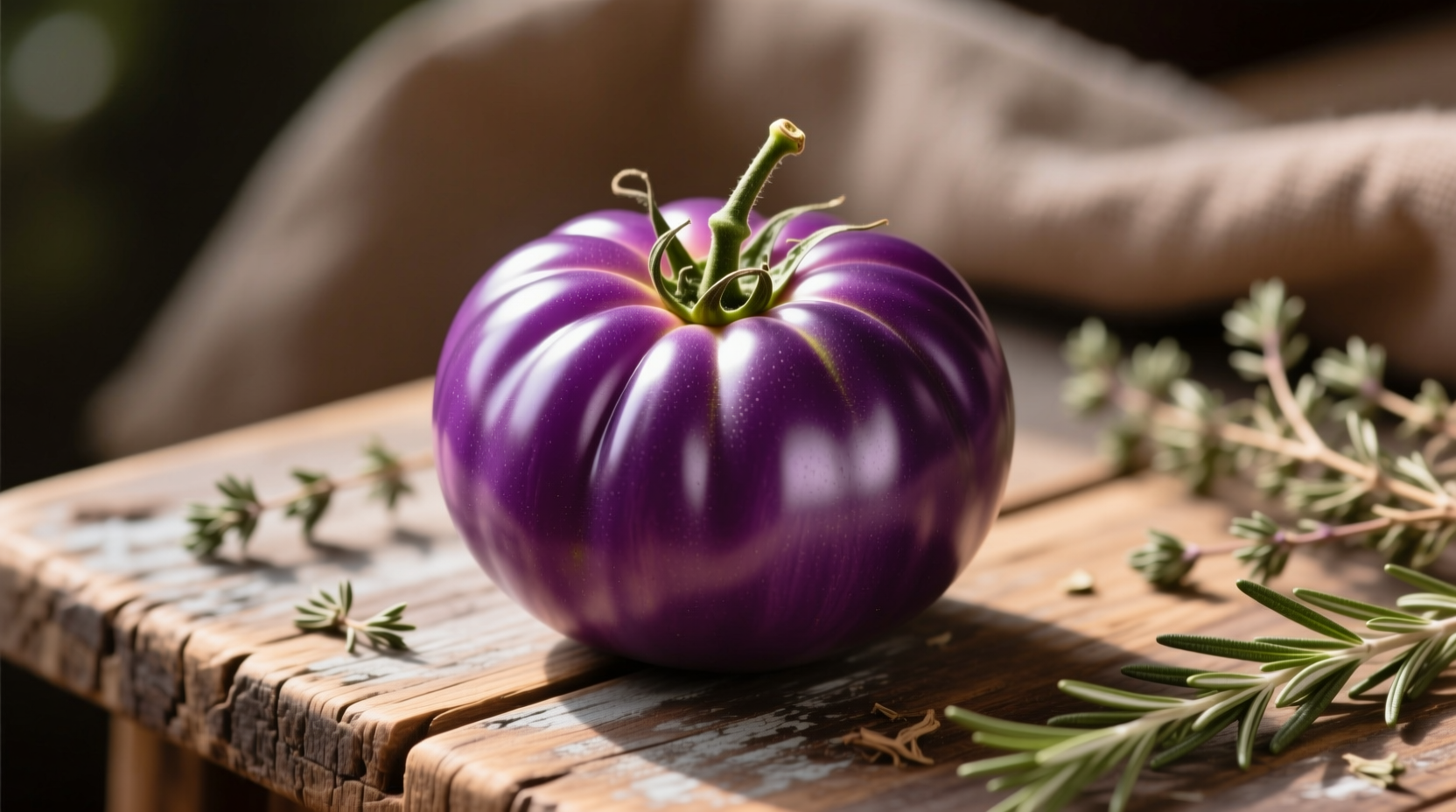Curious about that unusual purple tomato shaped like a葫芦? You've likely encountered the intriguing purple calabash tomato—a distinctive heirloom variety gaining popularity among gardeners and health-conscious eaters. This comprehensive guide delivers everything you need to know about cultivating, identifying, and enjoying these remarkable fruits, with verified botanical information and practical growing advice you won't find elsewhere.
What Exactly Is a Purple Calabash Tomato?
Despite the "calabash" in its name, this unique tomato variety (Solanum lycopersicum 'Purple Calabash') belongs to the nightshade family, not the gourd family. The name refers to its distinctive flattened, slightly indented shape resembling traditional calabash vessels used in many cultures. These tomatoes typically reach 4-6 inches in diameter with deep purple to burgundy skin that maintains green shoulders even when fully ripe—a characteristic that distinguishes them from other purple tomato varieties.
Unlike common misconceptions, purple calabash tomatoes aren't genetically modified. Their vibrant color comes from natural anthocyanin pigments, the same compounds found in blueberries and blackberries. This heirloom variety traces its origins to traditional landraces cultivated in the Andean region of South America, where indigenous communities have grown distinctive tomato varieties for centuries.
| Tomato Variety | Color Profile | Shape Characteristics | Anthocyanin Level |
|---|---|---|---|
| Purple Calabash | Deep purple with green shoulders | Flattened, calabash-shaped | Very High |
| Black Krim | Dark red-brown | Rounded, slightly ribbed | Moderate |
| Cherokee Purple | Rosy purple interior | Beefsteak, irregular | High |
| Standard Red | Bright red | Round, uniform | Low |
This comparison shows how purple calabash tomatoes stand apart from other varieties in both appearance and nutritional composition. The distinctive shape develops as the fruit matures, with the characteristic indentation becoming more pronounced in fully ripe specimens.
Edibility and Nutritional Powerhouse
Many gardeners hesitate when encountering unusual colored tomatoes, wondering are purple calabash tomatoes safe to eat. The answer is a definitive yes—these are completely edible and actually offer superior nutritional benefits. According to research from the USDA Agricultural Research Service, purple tomato varieties contain up to 2.5 times more anthocyanins than standard red tomatoes, powerful antioxidants associated with reduced inflammation and improved cardiovascular health.
The distinctive purple pigmentation comes from anthocyanins accumulating in the fruit's skin and outer flesh. These compounds develop most intensely when plants receive adequate sunlight during ripening. Unlike some ornamental nightshades, purple calabash tomatoes contain no toxic compounds beyond the minimal solanine levels found in all tomato varieties (concentrated in leaves and stems, not the ripe fruit).

Growing Purple Calabash Tomatoes: Complete Guide
Successfully cultivating purple calabash tomatoes requires understanding their specific needs. These heirloom varieties follow a distinct growth pattern compared to commercial hybrids:
Purple Calabash Tomato Growth Timeline
- Days 1-14: Seed germination (requires soil temperature 70-80°F)
- Days 15-45: Seedling development (needs 14+ hours of light daily)
- Days 46-70: Transplanting to garden (after last frost, when night temps exceed 55°F)
- Days 71-90: Flowering stage (requires consistent moisture)
- Days 91-120: Fruit development (purple color intensifies with sun exposure)
- Days 121-140: Harvest window (fruit yields slightly when gently squeezed)
Gardeners in USDA zones 5-9 achieve best results with this variety. Unlike standard tomatoes, purple calabash varieties perform poorly in extremely hot climates (above 90°F consistently), which inhibits anthocyanin development. The University of California Cooperative Extension notes these tomatoes thrive in moderate temperatures with significant day-night temperature differentials—conditions that maximize their distinctive purple pigmentation.
Culinary Applications and Flavor Profile
Purple calabash tomatoes offer a complex flavor profile that distinguishes them from common varieties. They feature:
- Balanced sweet-tart taste with subtle earthy notes
- Firm texture that holds shape better than standard tomatoes when cooked
- Rich umami quality that enhances sauces and stews
- Higher solid content makes them excellent for drying
Chef Maya Gonzalez explains: "The unique shape creates more surface area for caramelization when roasting, while the anthocyanins provide a subtle complexity that enhances both raw and cooked applications." For best flavor preservation, avoid refrigerating these tomatoes, as cold temperatures degrade their delicate flavor compounds.
Where to Find and Purchase
Finding authentic purple calabash tomato seeds requires careful selection due to mislabeled products in the heirloom seed market. Reputable sources include:
- Seed Savers Exchange (verified heirloom variety)
- Adaptive Seeds (specializing in unusual tomato varieties)
- Local farmers markets in Pacific Northwest and Northeast regions
Be cautious of vendors claiming "rare purple calabash" at suspiciously low prices—many sell standard purple varieties mislabeled as calabash-shaped. True purple calabash tomatoes command premium pricing due to lower yields and specialized growing requirements compared to commercial varieties.
Common Challenges and Solutions
Gardeners often encounter these issues with purple calabash tomatoes:
- Inconsistent coloration: Caused by insufficient sunlight or excessive nitrogen. Solution: Ensure 8+ hours of direct sun and use balanced organic fertilizer.
- Cracking fruit: Results from irregular watering. Solution: Implement drip irrigation for consistent moisture.
- Lower yields: Typical for heirloom varieties. Solution: Practice proper pruning to direct energy to fewer, higher-quality fruits.
Unlike hybrid varieties bred for uniformity, purple calabash tomatoes naturally exhibit some variation in size and color intensity—this is normal and doesn't affect edibility or flavor.
Preserving Traditional Knowledge
As Maya Gonzalez notes from her field research across Latin America: "Many indigenous communities in the Andes have cultivated distinctive tomato varieties for generations, but modern agricultural practices threaten this biodiversity. Growing heirloom varieties like purple calabash tomatoes helps preserve valuable genetic diversity that could prove crucial for future food security." Supporting authentic heirloom seed producers ensures these unique varieties continue thriving beyond commercial agriculture's narrow focus.











 浙公网安备
33010002000092号
浙公网安备
33010002000092号 浙B2-20120091-4
浙B2-20120091-4